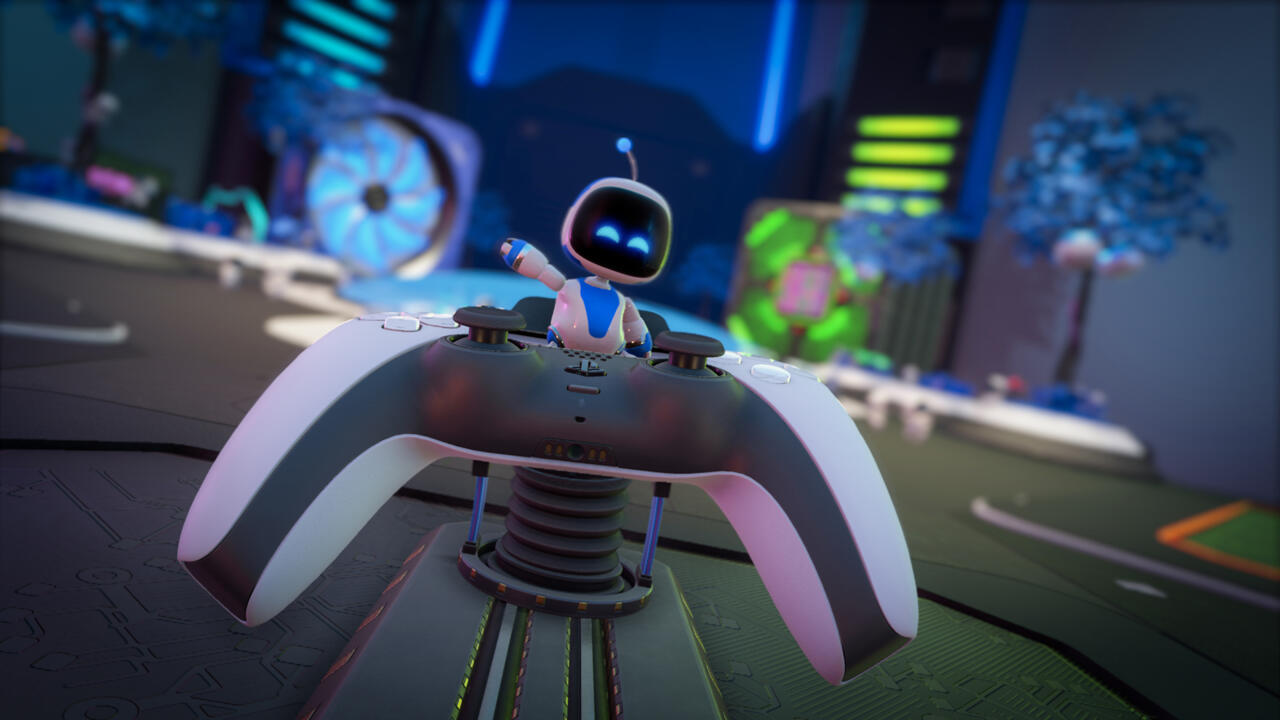Fast load times and spiffy graphics are nice, but the thing that has impressed me most about the PlayStation 5 so far is the DualSense controller. Sony's new gamepad is inundated with technological bells and whistles that can augment gameplay in a variety of ways. When it's fully utilized, the DualSense is maybe the most exciting element of the PS5, and the thing most likely to change the way you experience games.
The best available example of what the DualSense can do is Astro's Playroom, the 3D platformer that comes pre-installed with the PS5. Though it's a game in its own right, Astro's Playroom is also largely a demonstration of all the DualSense's capabilities. It puts a big emphasis on haptic feedback, the tactile sensations created by the controller's vibrations and rumbles, while also showing off the controller's adaptive triggers, its microphone and speaker, and older technologies such as the touchpad and internal gyroscope. All those elements together help elevate Astro's Playroom, taking it from being a fairly standard platformer to something that feels unique to the next generation.
The haptics in Astro's Playroom are extremely impressive. Pretty much everything you do in the game triggers a controller rumble of some sort or another. What makes the DualSense controller vibration cool is that it's much more targeted and specific than in past controllers--it doesn't just shake all over whenever you hit the ground or something explodes. The enhanced haptics allow the DualSense to shake in very specific ways.
In Astro's Playroom, you'll not only feel haptic feedback when Astro walks around, for example, but the controller has specific feedback based on what surface Astro is crossing. His metal feet clinking on a metal surface create specific points of vibration in the controller, alternating on the left and right side as he takes steps. Skating over frozen patches of ice produces what feels like a thinner, more central sensation. When it rains, you feel small impacts all over the controller, but hop onto a thick cloud and the sensation is a soft, generalized rumble.
The haptic feedback is constant throughout Astro's Playroom, creating a whole host of different sensations as you work through the game. But it takes advantage of the DualSense in other ways as well. Several mechanics make use of the adaptive triggers, which change tension based on what's happening in the game. The effect makes it so that holding down a spring or pulling back a bow string corresponds with a more resistant pull of the trigger, simulating what you're actually doing in the game a little more closely.
And the DualSense also sports some older technology that was part of Sony's past controllers. It sports a touchpad in the center, which allows you to sometimes use touch controls to do something like roll a ball around a level, and an internal gyroscope, which gives you control by tilting and moving your whole controller around. It also has a built-in speaker that adds small contextual sounds, which often works with the haptics to combine a feeling with a sound, giving your brain a little more context for what you're feeling. (The speaker now comes with a microphone, too, which is nice for talking to other players and occasionally gets used in Astro gameplay.) These are things we've seen in PlayStation games before with the DualShock 4 and SixAxis controllers, but they combine with new features in the DualSense to create some newer experiences.

Astro's Playroom functions as a great showcase for what the DualSense is capable of, but if there's a drawback to the controller, it's that so many of its features seem like they might not get much use on a broad swathe of games--especially if those games are available on multiple platforms.
Take Spider-Man: Miles Morales, for instance. Like Astro's Playroom, SM:MM is a PS5 launch title made by a first-party Sony developer, and it has a few cool DualSense-specific features. You can feel the adaptive triggers setting different tensions as you swing around the city or yank a weapon out of an enemy's hands with your webs, and using webs is augmented by little thwip sounds generated by the DualSense's speaker. Certain moments, like Miles riding the subway, push the haptics in interesting ways, with the controller simulating the feel of the tracks beneath Spider-Man's feet. But the game doesn't have nearly the dedication to the DualSense that Astro's Playroom does--while there are some sta\ndout moments, most of the time, I didn't notice much in the way of novel feelings and experiences from the controller.
SM:MM is also a PS4 game, so the fact that not every version of the game can use the DualSense might have made it difficult for developer Insomniac Games to spend too much time on the controller. It's also new tech, so developers might still be learning how to best utilize it. In any event, though, the DualSense is a nice addition that doesn't really change the Spider-Man experience.

Sony has had some very technologically impressive devices in the past, ones that have offered new gameplay potential, and which didn't see broad adoption. The DualShock 4's touchpad, light bar, and gyroscope went largely underutilized last generation, for instance. The PlayStation Vita was capable of all kinds of cool things, thanks to its back touchpad, on-board camera and microphone, and touchscreen--but one of the few games that really made use of the features of either the Vita or the DualShock 4 was Tearaway. Media Molecule's platformer was, much like Astro's Playroom, a showcase for all the cool things you could do with Sony's devices, but that game didn't inspire a wave of novel uses for hardware from other developers.
As a piece of next-generation technology, the DualSense offers developers and players a lot. Some of its features seem like they could offer cool new gameplay avenues for developers, and new ways to more closely connect what's happening on screen with what players feel and experience as they play. That will only happen if developers embrace the hardware, though--and there hasn't been a great track record in that regard over the last two generations. If you're picking up a PS5, you should play Astro's Playroom and see what some of this next-gen tech is capable of delivering, because the DualSense is an intriguing and fresh bit of video game hardware. Hopefully its features will see wide adoption as we enter the PS5 generation.






